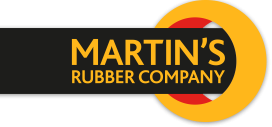


Yes, at Martin’s Rubber we look to create the most effective rubber solution to meet your project requirements, whatever they may be. It is important to remember that the customer remains responsible for warranting the effectiveness, safety and performance of any industrial rubber design or any alternative proposed by Martin’s Rubber, as well as the proving of samples or production parts in service.
The design stage of rubber and elastomeric components can vary from the creation or modification of 3D files to the provision of 2D drawings for parts, as well as Finite Element Analysis. Although we do not offer design services to generate original parts from scratch, we do work with customers to refine the design of their product.
The optimal approach is to involve our technical team from the very start of a project. This is important, as it prevents wasting design time or incorrect material selections. Customers have often approached us with high-cost products already in use that do not work. In such cases, we can reverse engineer a solution to help them solve their problem.
Yes, our staff have the technical expertise to help guide you on specific projects. Although we do not directly design rubber products ourselves, we can offer a consultation service to designers, where we make suggestions regarding:
Compression moulding can be used for large or intricate parts where a flat gasket would not be suitable. Compression moulding can offer a lower cost than other types of moulding processes, as the process does not require an injection or transfer cycle.
Compression moulding is also perfect for large parts that require a significant amount of material for manufacturing. The material can be directly loaded into the mould cavity so there is less limitation on the weight of part they can produce.
Some of the benefits that injection moulding offers include the fact that it can be used to produce very small parts, therefore it is perfect for both high-output production or fast production. You can also rest assured that injection moulding offers a good level of product consistency, so you can be sure your product will perform as expected. For further information about the benefits of injection moulding, simply follow the link.
The way rubber injection moulding works is that heated rubber is forced from a barrel into a mould with multiple cavities, where the rubber cures and cools. Rubber injection moulding is largely considered to be one of the most efficient ways to create rubber moulded products.
Here is a breakdown of the full rubber moulding process:
Rubber compression moulding uses raw compound that has been shaped similarly to the end product (pre-forms), which is then placed inside the cavity under heat and pressure to cure. There are many benefits of rubber compression moulding including reduced waste, cost-effective production, ideal for products with longer cure times and larger cross-sections.
Here is a short summary of the rubber compression moulding process:
Silicone rubber is a great moulding material. Known for having great resistance to chemicals and high temperatures, silicone rubber can also reproduce good levels of detail during the moulding process and is available in a range of colours, making it ideal for aesthetic parts. It is also known for its flexibility and durability which both allows the substance to be removed from the mould easily, and supports multiple cavities.
There are three types of rubber moulding process – compression moulding, transfer moulding and injection moulding. Here is a brief description of what each process entails:
For more information about the advantages and disadvantages of these rubber moulding methods, visit our rubber moulding facilities page.
Yes, Natural Rubber can be injection moulded. Natural rubber is one of the most widely used rubbers when it comes to rubber injection moulding. Natural rubber has high tensile strength, is abrasive and has good surface friction properties. It also bonds well with metals and is known for its flexibility and durability making it ideal for the injection moulding process and is the reason it has been used for many years.
Natural rubber is made from a liquid substance that oozes from some plants when you cut into them. This substance is called latex and it is commonly found in dandelions. For example, if you snap off a dandelion stem you will be able to see the latex dripping from the bottom. There are also several species of trees that produce rubber, including the Hevea Brasiliensis and those from the mulberry and fig families.
Vulcanised rubber was made reputedly by accident. Charles Goodyear dropped a sheet of fabric infused with rubber, sulphur and white lead onto a hot stove. Rather than melting, the fabric hardened into a permanent flexible state, and was far less affected by extreme heat than it had been. When placed in a steam oven under pressure, the combined rubber and sulphur cured to form a stable material that had good mechanical properties.
Still have a question?
Contact us using the below details…

Know exactly what you want? Upload your drawings so we can provide a tailored solution
Get in touch with us today by email [email protected]